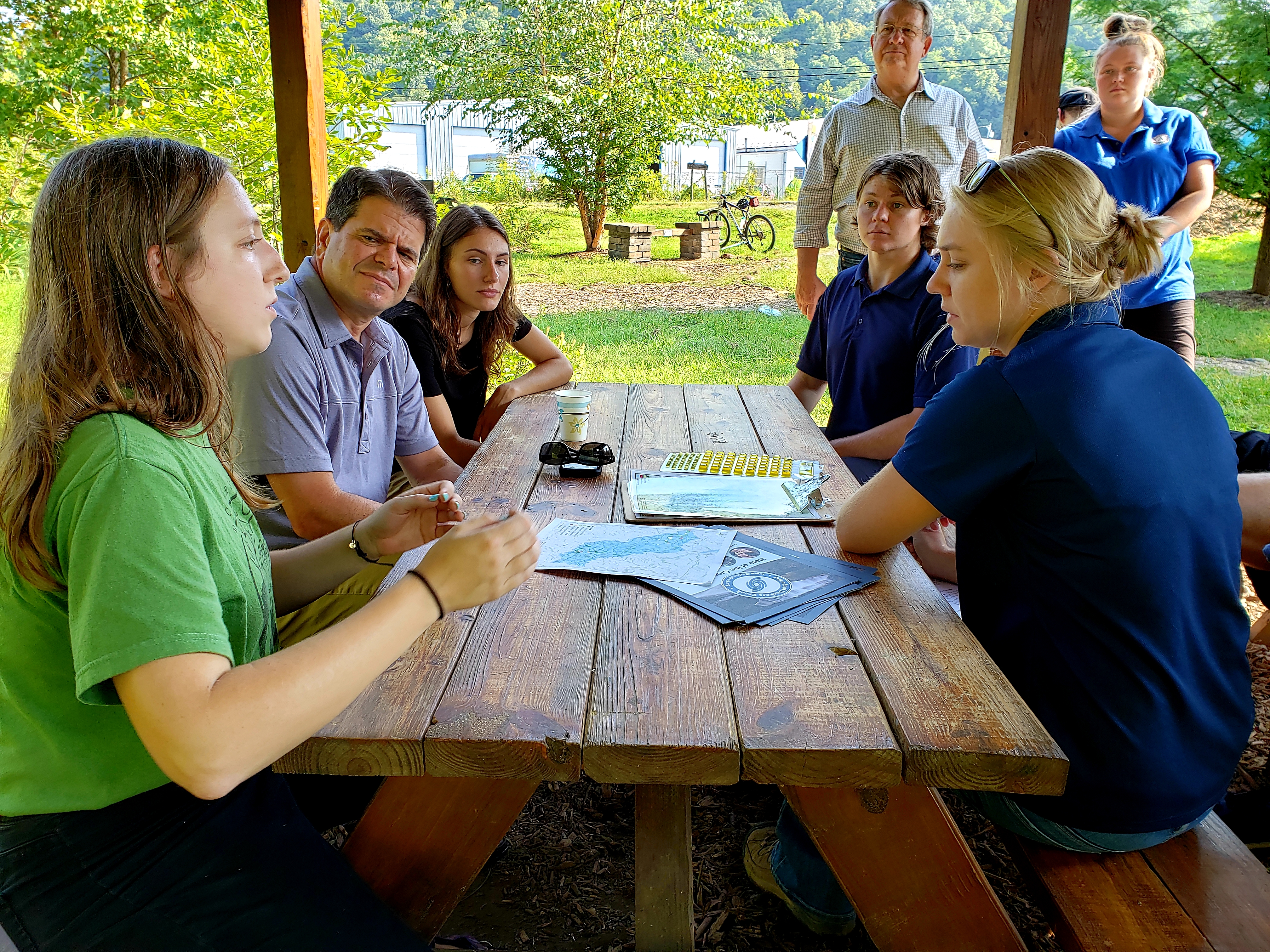MORGANTOWN — The Mid-Atlantic regional administrator of the EPA paid a visit to Friends of Deckers Creek Wednesday morning to watch them at work and learn what they’re doing with a recent $120,000 EPA grant.
Cosmo Servidio oversees Region 3, which covers five states and Washington, D.C. But he has strong West Virginia ties: He earned his bachelor’s degree at Wheeling Jesuit and his wife is from Fairmont, so they’re back here as often as they can be for family events.

FODC staff and volunteers were holding a work day at the Outdoor Learning Park behind the Sabraton Kroger. Servidio and the staff took a look at the creek then gathered around one of the picnic tables to talk about FODC’s EPA-funded e-coli project.
FODC Executive Director Sarah Cayton told Servidio that with the creek seeing significant improvement in acid mine drainage levels and the Richard Mine remediation project in the works – in the hands of the Department of Environmental Protection and the Natural Resources Conservation Service – FODC has been able to expand its focus.

Deckers Creek is on the EPA’s list of impaired creeks for e-coli levels, she said. “We really don’t have a lot of data on it.”
People often want to know if it’s safe to swim in the creek, and this is a way to find out. Last year, FODC was one of 10 agencies to receive an EPA Environmental Justice Cooperative Problem Solving Grant and they’re using it to do a full-scale e-coli study of the whole watershed.
Their goal is to develop a swim guide that will be available via an app so people can track the day’s readings and know where it’s safe to swim. Friends of the Cheat has a similar offering.
The two year grant began in September 2018, she said. They’ve been taking 40 samples per month, to measure e-coli and coliform bacteria, to get an idea of where it’s impaired, where it’s not, and craft a plan to fix it.
They’re beginning Phase II, Cayton said. They want to engage a storm water engineer to design a plan with remediation steps. After the grant expires, they hope to keep working with Morgantown Utility Board and other municipalities to address impaired areas piece by piece.
Maddie Ferrell, an FODC AmeriCorps VISTA staffer, told Servidio that they’ve been sending their samples off to WVU for test results, but they now have their own equipment and will be able to test in-house – still doing some backup and comparison testing at WVU. They also send 10 samples per month to Pace Analytical, a certified lab in Morgantown for independent results.
Servidio was pleased with their work “It’s all about the data and the sampling,” he said, about sharing the information.
He thanked them for their commitment to Deckers Creek and talked about the EPA’s goal: achieving a Balance of protecting the environment and seeing the economy thrive.
“Environmental cleanup never happens as quickly as we want it to,” he said. “There’s a process to it. It has to start somewhere. It’s the energy of what all of you are doing today that we build upon.”
Servidio also told them there’s more EPA money out there. “I’m always amazed at all the dollars that are out there.”
Servidio had to head to a brownfields conference and the staff and volunteers returned to their work.
Cayton took a few moments to elaborate on the e-coli project.
With one year left on the grant, she said, they have enough data to start analyzing. Toward spring they want to conduct some public meetings to share their findings.
Referring to the swim guide, she said, “So far we’re seeing good results in the gorge. That’s a nice area.”
But remediation won’t happen overnight. “It’s definitely a long process.”
At the lower end of the creek, Cayton said, e-coli problems stem in part from combined sewer overflows – when heavy rainfalls exceed the capacity of the system and cause mixed rain water and sewer to empty into the creek or its tributaries.
So FODC has met with MUB’s storm water engineer to look over MUB’s maps of combined sewer overflows to get a picture of the problem. “They’ve been super cooperative, encouraging even.”
MUB spokesman Chris Dale commented on the partnership in an email exchange. “Our partnership with FODC is information sharing. As part of our storm water permit we are required to do annual testing for fecal coliform in streams with storm water outfalls, which comes to eight locations.
“What we normally do is collect the samples and submit them to Pace Laboratories to be analyzed. The benefit to us in the partnership is that FODC is sampling specifically for e-coli, which we do not. By sharing data we hope to get a better picture of not just the threats to community waters but identify locations that may contain higher pollutants than others.
“The sampling will also provide us a better snapshot of how combined sewer overflows (CSOs)are impacting water environments and the impact of any CSO remediation efforts. We have a terrific relationship with FODC and partner with them on a variety of community projects, with this being just one of those.”
Tweet David Beard @dbeardtdp Email dbeard@dominionpost.com




